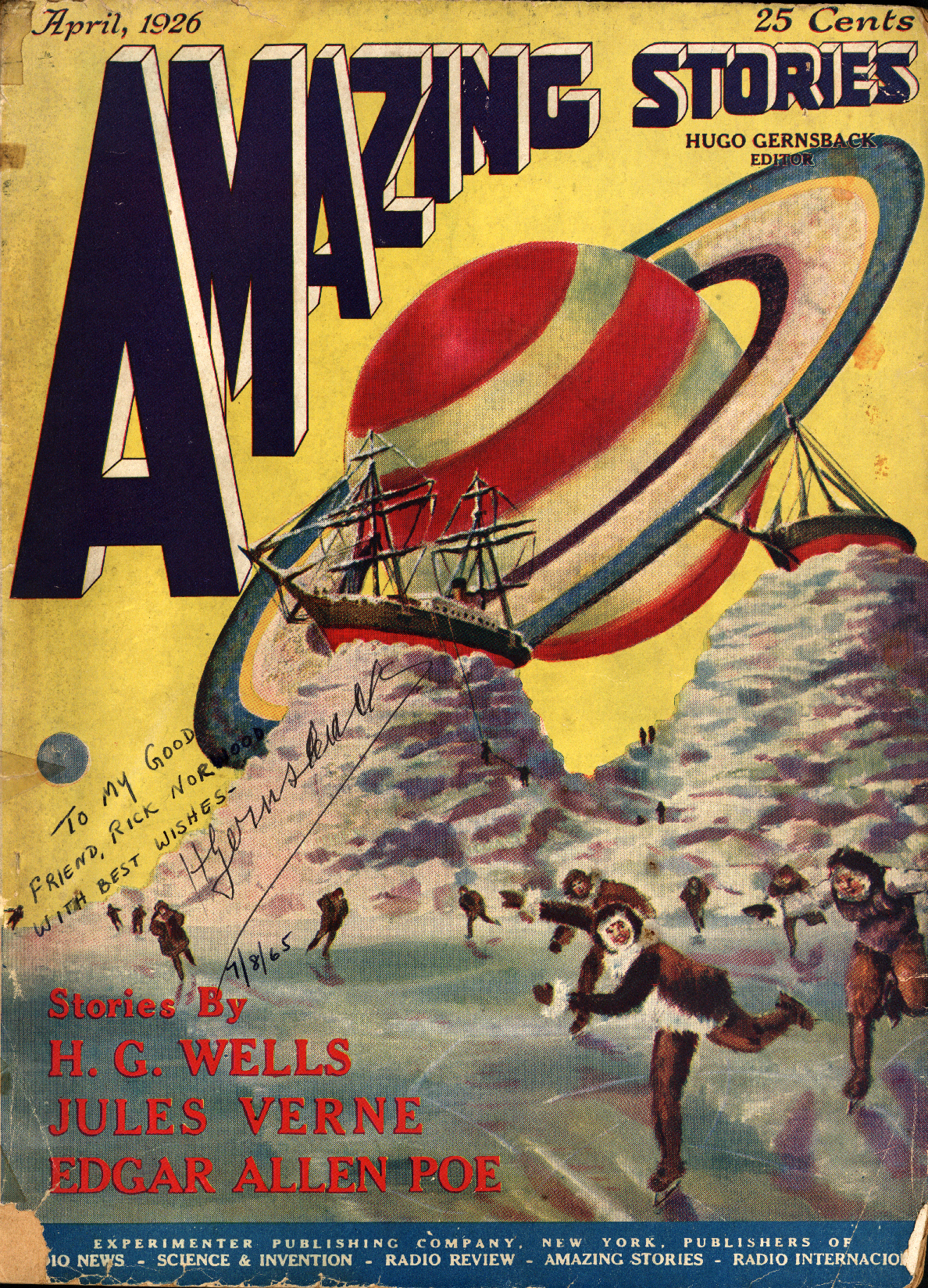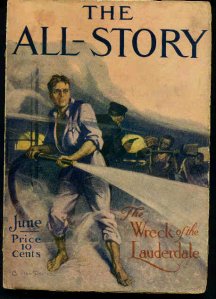|
Roger Sherman Hoar
Roger Sherman Hoar (April 8, 1887 – October 10, 1963) was an American state senator and assistant Attorney General, for the state of Massachusetts. He wrote and published science fiction under the pseudonym of Ralph Milne Farley. Family Hoar was the son of Sherman Hoar, grandson of former US Attorney General Ebenezer Rockwood Hoar, great-grandson of Samuel Hoar, and great-great grandson of American founding father Roger Sherman, a signer of the Declaration of Independence. Education and career Born in Waltham, Massachusetts, Hoar attended Phillips Exeter Academy. He then received his bachelor's degree from Harvard University in 1909 and his law degree from Harvard Law School in 1911. During World War I, he served in the United States Army Coast Artillery Corps. Hoar was a former Massachusetts assistant attorney general. He was a member of the Marquette University faculty in the graduate school of engineering, and also "taught scientific subjects at Harvard, the Coast Artillery ... [...More Info...] [...Related Items...] OR: [Wikipedia] [Google] [Baidu] |
Roger Sherman Hoar
Roger Sherman Hoar (April 8, 1887 – October 10, 1963) was an American state senator and assistant Attorney General, for the state of Massachusetts. He wrote and published science fiction under the pseudonym of Ralph Milne Farley. Family Hoar was the son of Sherman Hoar, grandson of former US Attorney General Ebenezer Rockwood Hoar, great-grandson of Samuel Hoar, and great-great grandson of American founding father Roger Sherman, a signer of the Declaration of Independence. Education and career Born in Waltham, Massachusetts, Hoar attended Phillips Exeter Academy. He then received his bachelor's degree from Harvard University in 1909 and his law degree from Harvard Law School in 1911. During World War I, he served in the United States Army Coast Artillery Corps. Hoar was a former Massachusetts assistant attorney general. He was a member of the Marquette University faculty in the graduate school of engineering, and also "taught scientific subjects at Harvard, the Coast Artillery ... [...More Info...] [...Related Items...] OR: [Wikipedia] [Google] [Baidu] |
Amazing Stories
''Amazing Stories'' is an American science fiction magazine launched in April 1926 by Hugo Gernsback's Experimenter Publishing. It was the first magazine devoted solely to science fiction. Science fiction stories had made regular appearances in other magazines, including some published by Gernsback, but ''Amazing'' helped define and launch a new genre of pulp fiction. As of 2018, ''Amazing'' has been published, with some interruptions, for 92 years, going through a half-dozen owners and many editors as it struggled to be profitable. Gernsback was forced into bankruptcy and lost control of the magazine in 1929. In 1938 it was purchased by Ziff-Davis, who hired Raymond A. Palmer as editor. Palmer made the magazine successful though it was not regarded as a quality magazine within the science fiction community. In the late 1940s ''Amazing'' presented as fact stories about the Shaver Mystery, a lurid mythos that explained accidents and disaster as the work of robots named deros, w ... [...More Info...] [...Related Items...] OR: [Wikipedia] [Google] [Baidu] |
Edgar Rice Burroughs
Edgar Rice Burroughs (September 1, 1875 – March 19, 1950) was an American author, best known for his prolific output in the adventure, science fiction, and fantasy genres. Best-known for creating the characters Tarzan and John Carter, he also wrote the ''Pellucidar'' series, the ''Amtor'' series, and the '' Caspak'' trilogy. Tarzan was immediately popular, and Burroughs capitalized on it in every way possible, including a syndicated Tarzan comic strip, movies, and merchandise. Tarzan remains one of the most successful fictional characters to this day and is a cultural icon. Burroughs's California ranch is now the center of the Tarzana neighborhood in Los Angeles, named after the character. Burroughs was an explicit supporter of eugenics and scientific racism in both his fiction and nonfiction; Tarzan was meant to reflect these concepts. Biography Early life and family Burroughs was born on September 1, 1875, in Chicago (he later lived for many years in the suburb of ... [...More Info...] [...Related Items...] OR: [Wikipedia] [Google] [Baidu] |
The Radio Man
''The Radio Man'' is a science fiction novel by American writer Ralph Milne Farley. It is the first book in Farley's ''Radio Man'' series. The novel was originally serialized from the June 28, 1924 issue of '' Argosy''. It was first published in book form in 1948 by Fantasy Publishing Company, Inc. in an edition of 1,000 copies. Modern publishers often release ''The Radio Man'' under the title ''An Earth Man on Venus''. Plot introduction The novel concerns electrical engineer Myles Cabot, who disappears from his home in Boston while performing an experiment. He finds himself transported to the planet Venus where he is captured by the Formians, a race of ant-like creatures. After learning of the Cupians, a human-like race that is subservient to the Formians, Cabot escapes and falls in love with the Cupian princess Lilla. He goes on to introduce the Cupians to gunpowder and leads them in a revolt against their Formian masters. Adaptations Wally Wood illustrated a 26-page a ... [...More Info...] [...Related Items...] OR: [Wikipedia] [Google] [Baidu] |
Science Fiction Fanzine
A science-fiction fanzine is an amateur or semi-professional magazine published by members of science-fiction fandom, from the 1930s to the present day. They were one of the earliest forms of fanzine, within one of which the term "''fanzine''" was coined, and at one time constituted the primary type of science-fictional fannish activity ("fanac"). Origins and history The first science-fiction fanzine, ''The Comet'', was published in 1930 by the Science Correspondence Club in Chicago. The term "fanzine" was neologism, coined by Russ Chauvenet in the October 1940 issue of his fanzine ''Detours''. in "Science Fiction Citations" for the Oxford English Dictionary "Fanzines" were distinguished from "prozines", that is, all professional magazines. Prior to that, the fan publications were known as "fanmags" or "letterzines." Traditionally, science-fiction fan ... [...More Info...] [...Related Items...] OR: [Wikipedia] [Google] [Baidu] |
Scientific American
''Scientific American'', informally abbreviated ''SciAm'' or sometimes ''SA'', is an American popular science magazine. Many famous scientists, including Albert Einstein and Nikola Tesla, have contributed articles to it. In print since 1845, it is the oldest continuously published magazine in the United States. ''Scientific American'' is owned by Springer Nature, which in turn is a subsidiary of Holtzbrinck Publishing Group. History ''Scientific American'' was founded by inventor and publisher Rufus Porter (painter), Rufus Porter in 1845 as a four-page weekly newspaper. The first issue of the large format newspaper was released August 28, 1845. Throughout its early years, much emphasis was placed on reports of what was going on at the United States Patent and Trademark Office, U.S. Patent Office. It also reported on a broad range of inventions including perpetual motion machines, an 1860 device for buoying vessels by Abraham Lincoln, and the universal joint which now can be found ... [...More Info...] [...Related Items...] OR: [Wikipedia] [Google] [Baidu] |
The American Mercury
''The American Mercury'' was an American magazine published from 1924Staff (Dec. 31, 1923)"Bichloride of Mercury."''Time''. to 1981. It was founded as the brainchild of H. L. Mencken and drama critic George Jean Nathan. The magazine featured writing by some of the most important writers in the United States through the 1920s and 1930s. After a change in ownership in the 1940s, the magazine attracted conservative writers, including William F. Buckley. A second change in ownership in the 1950s turned the magazine into a far-right and virulently anti-Semitic publication. It was published monthly in New York City. The magazine went out of business in 1981, having spent the last 25 years of its existence in decline and controversy. History H. L. Mencken and George Jean Nathan had previously edited ''The Smart Set'' literary magazine, when not producing their own books and, in Mencken's case, regular journalism for ''The Baltimore Sun''. With their mutual book publisher Alfred A ... [...More Info...] [...Related Items...] OR: [Wikipedia] [Google] [Baidu] |
Argosy All-Story Weekly
''Argosy'', later titled ''The Argosy'', ''Argosy All-Story Weekly'' and ''The New Golden Argosy'', was an American pulp magazine from 1882 through 1978, published by Frank Munsey until its sale to Popular Publications in 1942. It is the first American pulp magazine. The magazine began as a children's weekly story–paper entitled ''The Golden Argosy''. In the era before the Second World War, ''Argosy'' was regarded as one of the "Big Four" pulp magazines (along with '' Blue Book'', '' Adventure'' and '' Short Stories''), the most prestigious publications in the pulp market, that many pulp magazine writers aspired to publish in. Lee Server, ''Danger Is My Business: an illustrated history of the Fabulous Pulp Magazines''. San Francisco: Chronicle Books. (1993) (pp. 22-6, 50) John Clute, discussing the American pulp magazines in the first two decades of the twentieth century, has described ''The Argosy'' and its companion ''The All-Story'' as "the most important pulps of their er ... [...More Info...] [...Related Items...] OR: [Wikipedia] [Google] [Baidu] |
An Earth Man On Venus Comic Book
An, AN, aN, or an may refer to: Businesses and organizations * Airlinair (IATA airline code AN) * Alleanza Nazionale, a former political party in Italy * AnimeNEXT, an annual anime convention located in New Jersey * Anime North, a Canadian anime convention * Ansett Australia, a major Australian airline group that is now defunct (IATA designator AN) * Apalachicola Northern Railroad (reporting mark AN) 1903–2002 ** AN Railway, a successor company, 2002– * Aryan Nations, a white supremacist religious organization * Australian National Railways Commission, an Australian rail operator from 1975 until 1987 * Antonov, a Ukrainian (formerly Soviet) aircraft manufacturing and services company, as a model prefix Entertainment and media * Antv, an Indonesian television network * ''Astronomische Nachrichten'', or ''Astronomical Notes'', an international astronomy journal * ''Avisa Nordland'', a Norwegian newspaper * ''Sweet Bean'' (あん), a 2015 Japanese film also known as ''An'' ... [...More Info...] [...Related Items...] OR: [Wikipedia] [Google] [Baidu] |
Women's Suffrage
Women's suffrage is the right of women to vote in elections. Beginning in the start of the 18th century, some people sought to change voting laws to allow women to vote. Liberal political parties would go on to grant women the right to vote, increasing the number of those parties' potential constituencies. National and international organizations formed to coordinate efforts towards women voting, especially the International Woman Suffrage Alliance (founded in 1904 in Berlin, Germany). Many instances occurred in recent centuries where women were selectively given, then stripped of, the right to vote. The first place in the world to award and maintain women's suffrage was New Jersey in 1776 (though in 1807 this was reverted so that only white men could vote). The first province to ''continuously'' allow women to vote was Pitcairn Islands in 1838, and the first sovereign nation was Norway in 1913, as the Kingdom of Hawai'i, which originally had universal suffrage in 1840, r ... [...More Info...] [...Related Items...] OR: [Wikipedia] [Google] [Baidu] |







